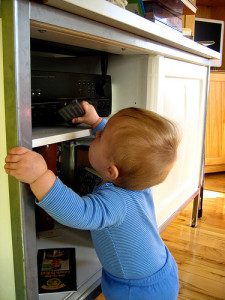
I’ve always had a bit of an overactive imagination, but the images created from the combination of hormones, new mommyhood, and fear are honestly terrifying. It easily took me 6 weeks to realize that my baby was not glass and that I would not damage him by walking across the parking lot to Target.
Thankfully the rational world has a solution to irrational me: facts and trained professionals.
In honor of Baby Safety Month, I asked Dr. Deborah Greenhouse of Palmetto Pediatrics and president of the South Carolina Chapter of the American Academy of Pediatrics to share some of her knowledge with me.
Most Common Yet Avoidable Injury :: Falling from a stationary object
Bed, chair, table, couch, etc. — if baby is above the ground, baby can fall to the ground. “The obvious solution is never to put the baby down and turn away for even a second, but it isn’t quite as easy as it sounds.”
We can’t hold baby all the time, so how do you avoid a fall? Use the safety strap on your changing pad, high chair and infant seat. If you must turn away from baby, put he or she somewhere a fall is not likely to happen. I may or may not have purposefully picked up a poopy baby from the changing table because I was out of wipes and had not yet learned to keep several packs in the drawer below.
Most Dangerous Places :: Hot Car, Stairs, Pool
The news has been plagued with stories of children dying in hot cars. It happened 44 times in 2013 and sadly, 2014 is moving forward at the same pace. It happens to parents from all walks of life, often with the common factor that their normal flow of life was changed or interrupted by something, or that they were distracted in such a way that their brain went on auto-pilot. As a result of these occurrences, a mommy friend of mine habitually puts her right shoe in the carseat so she will remember to check. Don’t like to drive with only one shoe? Put your purse back there. Your phone. Both shoes. Anything to make you look twice. Find out other ways on how to help keep kids safe in cars.
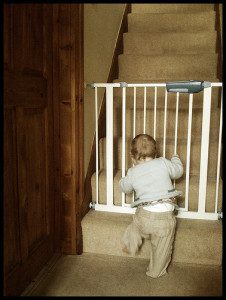
Stairs are dangerous. I trip up stairs and I’m a grown woman. If your child is walking, use gates, close doors, and keep baby on the ground floor. If your baby isn’t a walker, don’t leave them unattended on the steps and take care when you are climbing or descending while holding baby.
Pools are also dangerous areas. Babies can’t swim. They don’t understand holding their breath. It’s best to keep them away from the pool, but if you must, do so safely. For pre-walkers, carry baby away from the waters edge. If you fall, baby falls as well. Want to let the little one experience the water? Check out mesh baby carriers. I’d recommend a ring sling. Or consider special infant floats and life jackets. Remember, always have an adult tending to baby in or near water. For little ones who are walking, keep a barrier between them and the water’s edge. Set up your picnic outside of the pool’s gate, make sure that your beach spot is far from the water, keep baby in a play pen, or wear baby. Although my own child isn’t mobile yet, I’ve heard from countless moms that babies are faster than you can give them credit for.
First Aid Kids Must Haves :: Band aids, Antibiotic Ointment, Pedialyte, Saline Drops, Acetaminophen, and Ibuprofen
Children get sick, and bumps and bruises are inevitable. We can’t always prevent these things from happening, but we can be prepared with a first aid kit to help with the pain. As a general guideline, use Pedialyte for vomiting and diarrhea, saline drops for congestion, and an antibiotic ointment for cuts and scrapes. If the situation doesn’t get better or your mommy intuition tells you something isn’t quite right, consult your pediatrician. When using acetaminophen and ibuprofen, follow the dosage on the weight chart. Always talk to your doctor first when considering using acetaminophen under 3 months, and don’t use Ibuprofen under 6 months.
Best Way to Babyproof :: Get Low
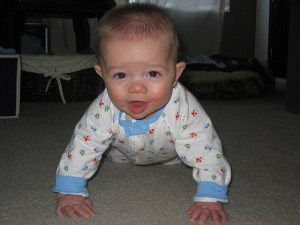
“The best way to baby proof a home is to sit down on the floor in every room that the baby has access to and look at it from the their point of view. That makes it pretty easy to know what you need to cover or move.” Don’t forget electrical outlet covers, and make sure fireplaces are blocked. Be sure to move medications and cleaners out of reach of baby, and use a latch on cabinets your little could access.
Keep in mind no house can be 100% babyproofed, but don’t let that statistic scare you. Do the best you can to keep the environment safe from obvious dangers. Dr. Greenhouse adds, “Babies explore and they get into things. That’s how they learn and they generally do just fine.”
What have you done (or plan to do) for babyproofing your surroundings? Share your own tips in the comments!
Baby Pulling Up Photo credit: found_drama / Foter / CC BY-NC-SA
Baby Gate Photo credit: rutty / Foter / CC BY-NC-SA
Crawling Baby Photo credit: mrplough / Foter / CC BY-SA


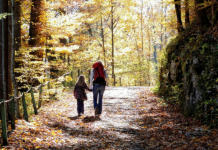
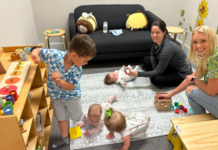

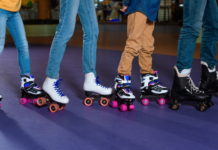


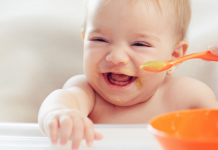






Dr. Greenhouse fan in the house! I’m an absolute klutz. I fell down the stairs just the other day and am so incredibly thankful our baby wasn’t in my arms. It’s the handrail for me from now on. Great advice for baby-proofing, which I’m afraid we’re going to have to do here soon – yikes!